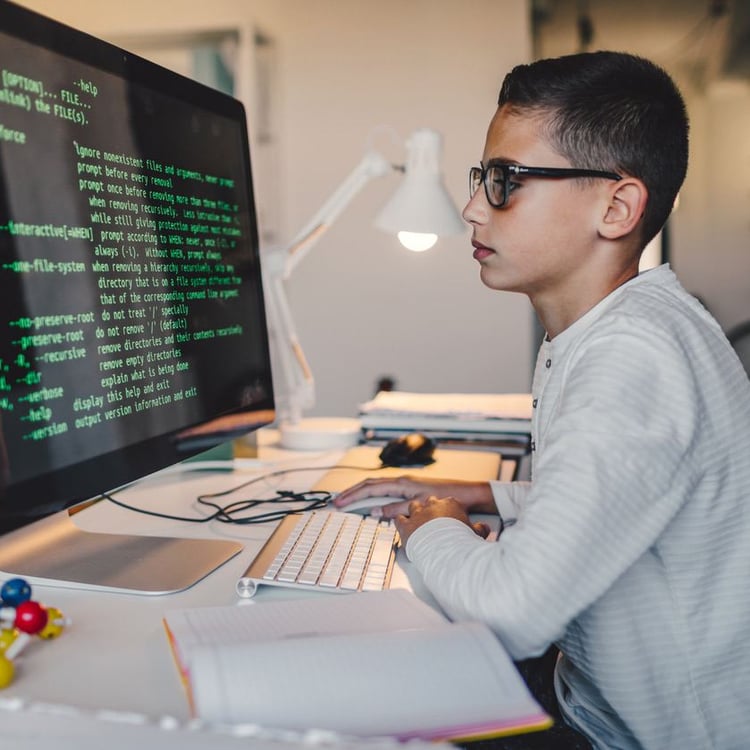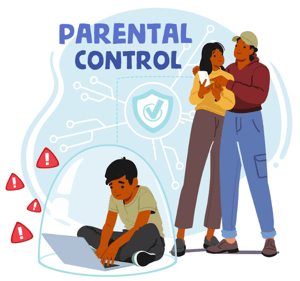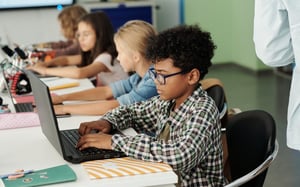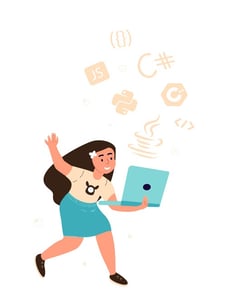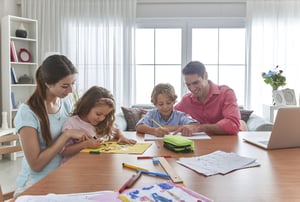In today’s digital age, understanding the basics of programming has become an essential skill for children. As technology continues to evolve, so does the need for younger generations to be equipped with the tools and knowledge to navigate and contribute to this ever-changing landscape. Introducing children to kid-friendly programming languages not only enhances their problem-solving skills but also fosters creativity and logical thinking from an early age.
Learning to code is no longer limited to those pursuing a career in computer science. It has become a valuable skill across various fields and industries. By starting early, children can develop a strong foundation in programming, opening doors to countless opportunities in the future. This article aims to guide parents and educators in selecting the best programming languages for kids, ensuring that the learning process is both enjoyable and educational.
Table of Contents
Why Teach Kids Programming?

Teaching kids programming offers a multitude of benefits that extend far beyond the realm of technology. One of the primary reasons to introduce children to coding is that it significantly enhances their problem-solving abilities. When kids learn to code, they are essentially learning how to break down complex problems into manageable steps, a skill that is highly transferable to many other areas of life.
Moreover, programming encourages creativity and innovation. By engaging with coding for kids, children can create their own games, animations, and websites, bringing their imaginative ideas to life. This process not only nurtures their creative thinking but also gives them a sense of accomplishment and boosts their confidence.
Another compelling reason to teach kids programming is the development of computational thinking. This type of thinking involves understanding how to formulate problems and solutions in a way that a computer can execute. This skill is invaluable in today’s digital world, where technology plays a pivotal role in almost every industry. Additionally, learning to code can help children understand and appreciate the technology they use daily, from smartphones to video games, making them more informed and responsible digital citizens.
Furthermore, the benefits of coding for children include improved academic performance. Studies have shown that coding helps with cognitive development and can improve skills in subjects such as math and science. The logical and structured approach required in programming often translates to better organizational skills and enhanced attention to detail in other academic areas.
Useful article: Coding for Beginners: A Step-by-Step Guide for Kids, Parents and Educators
Criteria for Kid-Friendly Programming Languages
Choosing the right programming language for children involves considering several key criteria to ensure the learning experience is both effective and enjoyable. Here are the main factors to consider:
- Simplicity. The language should have an easy-to-understand syntax and a user-friendly interface, making it accessible for young learners.
- Visual Elements. Languages that incorporate visual programming, such as block-based coding, are often more engaging for children and help them grasp fundamental concepts without getting bogged down by complex syntax.
- Interactive and Fun. The programming environment should be interactive and fun, encouraging kids to experiment and learn through play.
- Educational Resources. Availability of comprehensive tutorials, guides, and community support is crucial for both children and their educators to facilitate the learning process.
- Scalability. The language should offer opportunities for progression, allowing children to advance to more complex projects as their skills improve.
By considering these criteria, parents and educators can select easy programming languages for kids that will provide a strong foundation in coding while keeping the learning process engaging and rewarding.
Useful article: 12 Best Kids Coding Languages
Top Kid-Friendly Programming Languages
When it comes to selecting the best programming languages for children, several options stand out due to their simplicity, engaging interfaces, and educational value. These languages are designed to introduce kids to the fundamentals of coding in a way that is both fun and accessible. Below are some of the top kid-friendly programming languages that are highly recommended for young learners.

Scratch

Scratch is a block-based visual programming language developed by MIT, specifically designed for children aged 8 to 16. Its intuitive drag-and-drop interface allows kids to create animations, games, and stories without worrying about complex syntax. By snapping together colorful code blocks, children can see immediate results of their work, making the learning process highly interactive and engaging.
One of the key benefits of Scratch is its strong community support. With countless tutorials, resources, and a platform where kids can share their projects, Scratch provides a collaborative environment that fosters creativity and learning. It is an excellent starting point for beginners, providing a solid foundation in programming concepts such as loops, conditionals, and variables.
Useful article: Scratch Programming | Learn the Basics
Blockly

Blockly, developed by Google, is another visual programming language that uses a block-based system similar to Scratch. Its simple and user-friendly interface makes it ideal for younger children or those new to coding. Blockly serves as a stepping stone, helping kids understand basic programming logic without having to write actual code.
What sets Blockly apart is its versatility. It can be used to generate code in several text-based languages like JavaScript, Python, and PHP, allowing children to transition smoothly to more advanced coding as they become more comfortable. Additionally, Blockly is often integrated into educational robotics and coding kits, providing hands-on learning experiences that reinforce coding concepts through physical interaction.
Python

Python is a powerful yet beginner-friendly text-based programming language that is widely used in education. Known for its clear and readable syntax, Python allows children to focus on learning programming concepts without getting overwhelmed by complex language rules. It is suitable for slightly older kids or those who have some prior experience with visual programming languages.
Python’s versatility extends beyond basic coding projects. It is used in web development, data analysis, artificial intelligence, and more, making it a valuable skill for the future. Numerous educational resources, including online courses and interactive platforms like CodaKid and CodeCombat, make Python accessible and engaging for young learners.
Lua

Lua is a lightweight, high-level scripting language often used in game development. It is particularly popular among children interested in creating their own games, as it is the scripting language behind Roblox, a widely-used game creation platform. Lua’s simple syntax and flexibility make it a great choice for kids who want to see immediate, practical applications of their coding skills.
Lua encourages children to learn through play, providing a fun and interactive way to grasp programming concepts. The robust community and extensive resources available for Lua, particularly within the Roblox environment, offer plenty of support and inspiration for young coders.
JavaScript

JavaScript is a text-based programming language essential for web development. Its versatility and widespread use make it an excellent choice for older children interested in creating interactive websites and web applications. JavaScript is particularly engaging because it allows kids to see the direct impact of their code on web pages in real time.
For beginners, platforms like Khan Academy and CodaKid offer structured courses that break down complex topics into manageable lessons. Learning JavaScript opens the door to understanding other web technologies such as HTML and CSS, providing a comprehensive introduction to web development.
Useful article: What is the best programming language for kids?
Tips for Parents and Educators

Introducing children to programming can be a rewarding experience, but it’s important to approach it with the right strategies to ensure success and enjoyment. Here are some key tips for parents and educators:
- Start with the Basics. Begin with simple, visual programming languages like Scratch or Blockly. These languages are designed to teach fundamental concepts in an engaging way, making them perfect for beginners.
- Encourage Exploration. Allow children to experiment and explore different projects. This helps them learn through trial and error, fostering a deeper understanding of coding concepts.
- Provide Resources. Utilize online courses, tutorials, and interactive platforms to supplement learning. Having access to a variety of resources can keep kids motivated and help them progress at their own pace.
- Create a Supportive Environment. Offer positive reinforcement and be patient with their learning process. Celebrate their successes and help them navigate challenges without frustration.
- Integrate Real-World Applications. Show how coding is used in everyday life and various professions. This can make learning more relevant and exciting, inspiring them to continue developing their skills.
By following these tips, parents and educators can create a nurturing environment that promotes curiosity, creativity, and a lifelong love for learning.
Empowering the Next Generation of Coders
Teaching children to code is an investment in their future, equipping them with critical skills that extend beyond the digital world. By starting with kid-friendly programming languages like Scratch, Blockly, Python, Lua, and JavaScript, kids can learn the basics of coding in a fun and engaging way. These languages provide a strong foundation, enabling young learners to progress to more advanced projects and applications.
Coding not only enhances problem-solving and creativity but also prepares children for a technology-driven future. With the right support and resources, parents and educators can help kids unlock their potential and cultivate a lifelong passion for learning.
Ready to get started? Explore our interactive, game-based coding courses at CodaKid and give your child the tools they need to become the next generation of innovators and creators.
